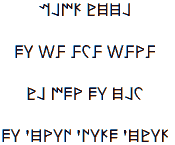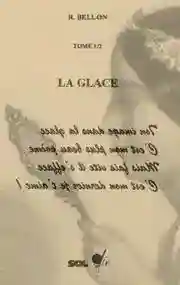Phoenician love poem
𐤄𐤇𐤋
𐤑𐤋𐤌𐤊 𐤁𐤇𐤇𐤋
𐤄𐤅 𐤔𐤉 𐤉𐤐𐤉 𐤔𐤉𐤓𐤉
𐤁𐤋 𐤌𐤄𐤓 𐤄𐤅 𐤇𐤋𐤐
𐤄𐤅 '𐤇𐤓𐤅𐤍 '𐤍𐤅𐤊𐤄 '𐤇𐤁𐤅𐤊

Transliteration
Haḥal
Ṣalmak baḥḥal
Hū šī yafē šīrī
Aval maher hū ḥalaf
Hū 'aḥarōn 'anōkh 'oḥebōk!
Explanations:
Haḥal = the mirror (Hebrew ḥalōn, Arabic ḥall)
Ṣalmak = your image (root s-l-m, "image" or "likeness")
Baḥḥal = in the mirror
Šīrī = my poem/song
Yafē = beautiful
Aval maher = but quickly
Ḥalaf = fades, disappears
'Anōkh = I (like biblical Hebrew)
'Oḥebōk = I love you

→ French poem ←
Phoenician
Here is my love poem translated into Phoenician (Canaanite), the West Semitic language of the Canaanite subgroup... the language of the Phoenicians, who lived in Canaan country, the coastal region of present-day Syria, Lebanon, and Israel, as well as in the regions colonized by the Phoenicians, particularly the southern coast of the Mediterranean basin.
Phoenician is one of the many dialects of the Canaanites. It comes from the south of the city of Sidon. A region called Püt, inhabited by the Ponnïm (Punicus in Latin). Its extension, along with Tyre, would extend much further north and south to give Phoenicia.
This dialect, from a small region of the Canaanite group, would become in the Near East an essential language, even a lingua franca, due to the commercial dynamism of Tyre and Sidon. The rise of Carthage in the 5th century BC elevated it to the rank of Greek and Latin.
The first inscriptions discovered (-1200) show that Phoenician flourished as a written language, using the Phoenician alphabet, for over a millennium.
While the Tyrosidonian variant established itself as the literary standard, we know, with the discovery of inscriptions, that other dialects to the north and south survived. Western Phoenician (Punic), was also a variant.
The Phoenician alphabet is an abjad, which only records consonant sounds. Phoenician traders spread it, with their language, throughout the Mediterranean basin. Many writing systems were derived from it.